be24c6f497fc34db46eb22af86d36273.ppt
- Количество слайдов: 128

Finance and the Firm 1

Learning Objectives v The field of finance v The duties of financial managers v The basic goal of a business firm v Legal and ethical challenges for financial managers v Forms of business organization 2

The Field of Finance v Financial Management – Analyze and forecast a firm’s performance – Evaluate investment opportunities v Financial Markets and Institutions – The flow of funds through institutions – Markets in which financial assets are sold – Impact of interest rates on that flow of funds v Investments – Locate, select, and manage money producing assets. 3

Financial Statements Balance Sheet Assets Liabilities Equity v Liabilities and equity represent sources of funds. v Assets represent uses of funds. v Liabilities represent a debt claim. v Equity represents an ownership claim. 4

Financial Management v. Capital Budgeting v. Capital Structure Policy v. Working Capital Management 5

Financial Management ST Assets ST Liabilities LT Assets LT Liabilities Equity v Capital Budgeting Ø Deals with the firm’s investment in long-term real assets Ø e. g. , in what projects should the firm invest? 6

Financial Management ST Assets ST Liabilities LT Assets LT Liabilities Equity v Capital Structure Policy Ø Deals with long-term financing of the firm’s activities Ø e. g. , what mix of long term debt and equity will the firm use? 7

Financial Management ST Assets ST Liabilities LT Assets LT Liabilities Equity v Working Capital Management Ø Deals with management of short-term (current) assets. Ø e. g. , will the firm purchase supplies on credit or pay cash? 8

Investments v Looks at financial analysis from perspectiv of investor Ø Stockholders are owners of the firm Ø Bondholders are creditors of the firm v From investor’s perspective, what matters is the rate of return on a security Ø Risk-return tradeoff: Investors prefer high returns to low returns and low risk to high risk. Ø From the firm’s perspective this rate of return represents a cost of funds. 9

Financial Markets and Institutions v Financial markets and institutions facilitate the flow of funds in the economy Ø This makes society more productive, thus increasing social welfare v Topics include: Ø How interest rate levels are determined Ø How the Fed controls the money supply Ø Relationships between macroeconomic variables such as inflation, interest rates, money supply and GDP. 10

Duties of Financial Managers v Measure a firm’s performance v Forecast financial consequences v Recommend new investment v Locate external financing v Recommend best financing mix v Determine financial expectations of owners 11

Basic Goal of the Business Firm v The primary financial goal of the business firm is to maximize the wealth of the firm’s owners (or the value of the firm). v This is not necessarily the same as “maximizing profits”. 12

Maximizing the "value” of a firm? v The value of a firm is determined by the discounted value of all future expected cash flows derived from the firms business activities. v The financial manager should make decisions that cause this value to be maximized. v Value depends on future prospects and risk. 13

Factors that affect the value of a firm’s stock price: v Cash flows – Necessary to pay the bills – Not the same as sales or profits v Timing of cash flows – Cash received sooner is better than cash received later v Risk – Definite cash inflows are generally preferred to uncertain cash inflows 14

Legal and Ethical Challenges v Agency issues Ø Managers are agents for the firm’s owners but they may have interests that conflict with those owners. Ø These agency conflicts impose costs (such as the cost of accounting audits). v Interests of non-owner stakeholders Ø Workers, creditors, suppliers, customers, and others are not owners, but may have a stake in the business. 15

Legal and Ethical Challenges v The interests of society as a whole may not coincide with the interests of owners of a firm. Ø Costs of disposing of toxic waste reduce owners’ profits. Ø There may be goodwill generated by voluntary actions that benefit society. Ø Sometimes the right thing must be done in spite of the cost to the company v Government often imposes rules that force companies to respond to the best interests of society. 16

Forms of Business Organization v Sole Proprietorship Ø Advantages • Easily Established • Minimal Organizational Costs • Keep all Generated Profits Ø Disadvantages • Unlimited Liability • Losses absorbed by owner • Limited Capital • Limited Life 17

Forms of Business Organization v General Partnership Ø Advantages • Minimal Organizational Requirements • Negligible Government Regulations Ø Disadvantages • Unlimited Liability • Must be Dissolved or Reorganized if a Partner Leaves or Dies 18

Forms of Business Organization v Limited Partnership (LP) Ø Two classes of partners • General Partners • Limited Partners Ø Every partnership must have at least one general partner 19

Forms of Business Organization v Limited Partnership (LP) General Partners ØAdvantages • Participate actively in management • More favorable allocation of ownership/profit/losses ØDisadvantages • Unlimited Liability 20

Forms of Business Organization v Limited Partnership (LP) Limited Partners ØAdvantages • Limited liability ØDisadvantages • not active in management • less favorable allocation of ownership/profit/losses 21

Forms of Business Organization v Limited Liability Partnership (LLP) ØSimilar to General Partnership • operates like a corporation • limited liability • partnership not taxed • income passed through to partners and partners are taxed 22

Forms of Business Organization v Corporation Ø A legal “person” separate and distinct from its owners • • Advantages – Limited Liability – Permanency – Transferability of Ownership – Better Access to Capital Disadvantages – Double Taxation – Time and Cost of Incorporation 23

Forms of Business Organization v Limited Liability Company (LLC) Ø A form of business organization that is a state-approved, unincorporated association. • Advantages – Limited Liability – No Double Taxation • Disadvantages – Relatively New - Some Legal Issues Not Yet Defined 24

Homework Questions 1. What is the fiduciary responsibility of an agent? 2. What is meant by double taxation? 3. Explain which type of business organization form affords the most control to the owner? 4. Why would someone choose a limited partnership share over a sole proprietorship? 5. How do agency problems arise? What are some examples of agency problems? What can corporations do to monitor these costs? 25

Financial Markets and Interest Rates 26

Learning Objectives • • • Operation of U. S. financial system. Financial securities. Function of financial intermediaries. Financial markets. Securities traded in the money and capital markets. 27

The Financial System The purpose of the financial system is to bring together individuals, businesses, and government entities (economic units) that generate and spend funds. Surplus economic units have funds left over after spending all they wish to spend. u Deficit economic units need to acquire additional funds to sustain their operations. u 28

The Financial System • To enable funds to move through the financial system, funds are exchanged for securities. • Securities are documents that represent the right to receive funds in the future. • Financial intermediaries discussed in Chapter 3 often help to facilitate this process. 29

Financial Markets • Classified according to the characteristics of participants and securities involved. • The primary market is where deficit economic units sell new securities to raise needed funds. 30

Financial Markets The Circular Flow of Income Funds Primary Market Securities Primary Market handles IPO’s (new public offerings) 31

Financial Markets • Classified according to the characteristics of participants and securities involved. • The primary market is where deficit economic units sell new securities. • The secondary market is where investors trade previously issued securities with each other. 32

Financial Markets Funds Secondary Market Securities The Circular Flow of Income 33

Financial Markets • Money Market vs. Capital Market 34

Financial Markets • Money Market – Trade short term (1 year or less) debt instruments (e. g. T-Bills, Commercial Paper) – Major money centers in Tokyo, London and New York • Capital Market – Trades long term securities (Bonds, Stocks) – NYSE, ASE, over-the-counter (Nasdaq and other OTC) 35

Financial Markets Intermediaries such as commercial banks and insurance companies help to facilitate the flow of funds in the financial marketplace. $$ Securities $$ 36

Market Efficiency • Market efficiency refers to the ease, speed, and cost of trading securities. – The market for the securities of large companies is generally efficient: Trades can be executed in a matter of seconds and commissions are very low. – The real estate market is not generally efficient: It can take months to sell a house and the commission is 6 -7% of the price. 37

Market Efficiency n Why is market efficiency important? – The more efficient the market, the easier it is to transfer idle funds to those parties that need the funds. – If funds remain idle, this results in lower growth for the economy and higher unemployment. – Investors can adjust their portfolios easily and at low cost as their needs and preferences change. 38

Securities in the Financial Market • Money Market Securities – Highly liquid, low risk – Treasury Bills (T-Bills) – Certificates of Deposit (CDs) – Commercial Paper – Eurodollars – Banker’s Acceptances 39

Securities in the Financial Market • Money Market Securities – Highly liquid, low risk – Treasury Bills (T-Bills) – are short-term securities • T-Bills: Certificates of Deposit (CDs)issued by the Federal. Commercial Paper – government. • After initial sale, they have an active secondary – Eurodollars market. – Banker’s Acceptances • They are bought at a discount and at maturity the investor receives the full face value. 40

Securities in the Financial Market • Money Market Securities – Highly liquid, low risk – Treasury Bills (T-Bills) – Certificates of Deposit (CDs) • Negotiable CDs: are interest-bearing securities – Commercial Paper issued Eurodollar institutions. – by financial • They have maturities of one year or less. – Banker’s Acceptances 41

Securities in the Financial Market • Money Market Securities – Highly liquid, low risk – Treasury Bills (T-Bills) – Certificates of Deposit (CDs) – Commercial Paper • Commercial paper: is unsecured debt issued – Eurodollars by corporations with good credit ratings. – Banker’s Acceptances • Most buyers are large institutions. 42

Securities in the Financial Market • Money Market Securities – Highly liquid, low risk – Treasury Bills (T-Bills) – Certificates of Deposit (CDs) – Commercial Paper – Eurodollars • Eurodollars: are dollar denominated, deposits, – Banker’s Acceptances located in non-US banks. • Buyers and sellers are large institutions. 43

Securities in the Financial Market • Money Market Securities – Highly liquid, low risk – Treasury Bills (T-Bills) – Certificates of Deposit (CDs) – Commercial Paper – Eurodollars – Banker’s Acceptances • Banker’s Acceptances: are debt securities that have been guaranteed by a bank. They are used 44 to facilitate international transactions.

Securities in the Financial Market • Money Market Securities – Highly liquid, low risk – Treasury Bills (T-Bills) – Certificates of Deposit (CDs) – Commercial Paper – Eurodollars – Banker’s Acceptances 45

Securities in the Financial Market • Capital Market Securities – Bonds • Bonds: are “IOUs” issued by the borrower and sold to investors. • The issuer promises to repay the face amount on the maturity date and to pay interest each year in the amount of the coupon rate times the face value. 46

Securities in the Financial Market n Capital Market Securities – Bonds Treasury Bonds • Treasury Bonds: are issued by the federal Municipal government. Bonds Corporate Bonds • Municipal Bonds: are issued by state and local governments. • Corporate Bonds: are issued by corporations. 47

Securities in the Financial Market n Capital Market Securities – Stock • Companies can also raise funds by selling shares of stock 48

Securities in the Financial Market n Capital Market Securities – Stock Common Stock • Common stockholders: own a portion of the company and can vote on major decisions. • They receive a return on their investment in the form of dividends and capital gains. 49

Securities in the Financial Market n Capital Market Securities – Stock Common Stock Preferred Stock • Preferred stockholders do not generally have voting rights, but have priority in receiving dividends and are paid dividends at a pre-set rate. 50

Interest Rates n Interest Rates Determined by – Real Rate of Interest – Expected Inflation – Default Risk – Maturity Risk – Illiquidity Risk 51

Interest Rates n Real Rate of Interest – Compensates for the lender’s lost opportunity to consume. 52

Interest Rates n Default Risk – For most securities, there is some risk that the borrower will not repay the interest and/or principal on time, or at all. – The greater the chance of default, the greater the interest rate the investor demands and the issuer must pay. 53

Interest Rates • Expected Inflation erodes the purchasing power of money. u Example: If you loan someone $1, 000 and they pay it back one year later with 10% interest, you will have $1, 100. But if prices have increased by 5%, then something that would have cost $1, 000 at the outset of the loan will now cost $1, 000(1. 05) = $1, 050. u 54

Interest Rates • Maturity Risk u u If interest rates rise, lenders may find that their loans are earning rates that are lower than what they could get on new loans. The risk of this occurring is higher for longer maturity loans. 55

Interest Rates • Maturity Risk u Lenders will adjust the premium they charge for this risk depending on whether they believe rates will go up or down. 56

Interest Rates • Illiquidity Investments that are easy to sell without losing value are more liquid. u Illiquid securities have a higher interest rate to compensate the lender for the inconvenience of being “stuck. ” u 57

Determination of Rates k = k* + IRP + DRP + MP + ILP k k* IRP DRP MP Il. P = the nominal, or observed rate on security = real rate of interest = Inflation Risk Premium = Default Risk Premium = Maturity Premium = Illiquidity Premium 58

Interest Rates • Term Structure Relationship between long and short term interest rates u Yield curve u 59

Treasury Yield Curve 8. 00% 7. 50% 3 month T-Bill 7. 00% 6. 50% 6. 00% 5. 50% 5. 00% Jan 10, 2006 4. 50% 4. 00% 3. 50% 3 6 mos. 1 yr. 2 3 5 7 10 20 maturities 60

Treasury Yield Curve 8. 00% 7. 50% 7. 00% 6. 50% 6 month T-Bill 6. 00% 5. 50% 5. 00% Jan 10, 2006 4. 50% 4. 00% 3. 50% 3 6 mos. 1 yr. 2 3 5 7 10 20 maturities 61

Treasury Yield Curve 8. 00% 7. 50% 7. 00% 1 year T -Bill 6. 50% 6. 00% 5. 50% 5. 00% Jan 10, 2006 4. 50% 4. 00% 3. 50% 3 6 mos. 1 yr. 2 3 5 7 10 20 maturities 62

Treasury Yield Curve 8. 00% 7. 50% 7. 00% 2 year T -Note 6. 50% 6. 00% 5. 50% 5. 00% Jan 10, 2006 4. 50% 4. 00% 3. 50% 3 6 mos. 1 yr. 2 3 5 7 10 20 maturities 63

Treasury Yield Curve 8. 00% 7. 50% 7. 00% 6. 50% 6. 00% 3 year T -Note 5. 50% 5. 00% Jan 10, 2006 4. 50% 4. 00% 3. 50% 3 6 mos. 1 yr. 2 3 5 7 10 20 maturities 64

Treasury Yield Curve 8. 00% 7. 50% 7. 00% 6. 50% 5 year T -Bond 6. 00% 5. 50% 5. 00% Jan 10, 2006 4. 50% 4. 00% 3. 50% 3 6 mos. 1 yr. 2 3 5 7 10 20 maturities 65

Treasury Yield Curve 8. 00% 7. 50% 7. 00% 6. 50% 6. 00% 5. 50% 5. 00% Jan 10, 2006 4. 50% 4. 00% 3. 50% 3 6 mos. 1 yr. 2 3 5 7 10 20 maturities 66

Treasury Yield Curve 8. 00% 7. 50% 7. 00% 6. 50% 6. 00% 5. 50% 5. 00% Jan 10, 2006 March 22, 1995 August 1, 2008 4. 50% 4. 00% 3. 50% 3 6 mos. 1 yr. 2 3 5 7 10 20 maturities 67

Homework Questions 1. Would the default premium on an investment grade corporate bond be higher or lower than that on a junk bond? Explain. 2. Explain the difference between a dealer and a broker. 3. The more liquid the financial instrument, the wider the spread between the bid and ask price. Explain why you agree or disagree with this statement. 4. The economy is suffering from a recession, explain what will happen to the yield spread between a Treasury bond a BBB rated corporate bond. 5. Explain how you earn a return on a Treasury bill. How is this different from the manner in which you earn a return on a Treasury note or bond? 68

Financial Institutions 69

Learning Objectives • The role of financial intermediaries. • Commercial banks and the impact of reserve requirements. • Federal Reserve regulation of financial institutions. • The difference between savings and loans and commercial banks. • Operation of credit unions. • Distinguish among finance companies, insurance companies, and pension funds. 70

The Role of Financial Institutions as Intermediaries (“Middle Persons”) • A household with surplus funds can “purchase” a savings account at a financial institution. The bank, S&L, or credit union channels those surplus funds to a firm, government entity, or a household that needs them. • In this way, small surplus units can be packaged together to meet the needs of large deficit economic units. 71

Services offered by Financial Institutions • Denomination matching 72

Services offered by Financial Institutions • Denomination matching – Households generally have small amounts of surplus funds to invest. They can put small amounts into savings at a time. 73

Services offered by Financial Institutions • Denomination matching – Households generally have small amounts of surplus funds to invest. They can put small amounts into savings at a time. – Those who need loans usually require larger amounts of funds. They can borrow for business purposes, or to buy a home or automobile. 74

Services offered by Financial Institutions • Maturity Matching – Household and business savers generally want to lend for only a short time. Savings and checking accounts are usually available for immediate withdrawal. 75

Services offered by Financial Institutions • Maturity Matching – Household and business savers generally want to lend for only a short time. Savings and checking accounts are usually available for immediate withdrawal. – Borrowers often want long-term financing. Institutions can give 30 year mortgages and long-term loans to businesses and government entities. 76

Services offered by Financial Institutions • Absorbing Credit Risk – Individual lenders cannot easily evaluate the credit risk of borrowers. They also cannot generally afford to take the risk of losing their limited savings. 77

Services offered by Financial Institutions • Absorbing Credit Risk – Individual lenders cannot easily evaluate the credit risk of borrowers. They also cannot generally afford to take the risk of losing their limited savings. – Institutions have the necessary expertise and also are in a better position to absorb an occasional loss. 78

The Role of Financial Institutions Intermediaries help to facilitate the flow of funds in the financial marketplace. $$ Securities Financial Institution Securities $$ 79

Financial Intermediation Example 1 $$ Businesses Commercial loans Checking accounts Commercial Bank Households $$ 80

Financial Intermediation Example 2 Insurance policies $$ Insurance Company Businesses Stocks, Bonds Households $$ 81

Types of Financial Institutions • Commercial Banks 82

Types of Financial Institutions • Commercial Banks The primary purpose of commercial banks is to take in business deposits and to lend funds to businesses. 83

Types of Financial Institutions • Commercial Banks • Savings and Loans 84

Types of Financial Institutions • Commercial Banks • Savings and Loans Savings and loans’ primary purpose is to take in deposits from households and to lend funds for home mortgages. 85

Types of Financial Institutions • Commercial Banks • Savings and Loans • Credit Unions 86

Types of Financial Institutions • Commercial Banks • Savings and Loans • Credit Unions 87

Types of Financial Institutions • Commercial Banks • Savings and Loans • Credit Unions } Depository Institutions 88

Types of Financial Institutions • Commercial Banks • Savings and Loans • Credit Unions } Depository Institutions • Take in deposits • Make loans 89

Types of Financial Institutions • Finance Companies 90

Types of Financial Institutions • Finance Companies Non-bank firms that borrow funds to make short and medium term loans to higher risk borrowers. 91

Types of Financial Institutions • Finance Companies • Insurance Companies 92

Types of Financial Institutions • Finance Companies • Insurance Companies Receive premiums for insurance policies. This pool of funds is used to reimburse policyholders who incur losses that are covered under the policy. Life Insurers: Insure against financial hardship caused by death. Property and Casualty: Insure against damage to person and property (health, autos, homes, theft, earthquake, etc. ) 93

Types of Financial Institutions Finance Companies Insurance Companies Pension Funds 94

Types of Financial Institutions • Finance Companies • Insurance Companies • Pension Funds Workers and/or employers contribute funds. Defined Benefit Plans (DBP) versus Defined Contribution Plans (DCP). 95

Types of Financial Institutions • Finance Companies • Insurance Companies • Pension Funds } Non. Depository Institutions 96

Types of Financial Institutions • Finance Companies • Insurance Companies • Pension Funds } Non. Depository Institutions • Funds come from borrowing, selling insurance policies, and other claims. • Funds used to buy securities and make loans. 97

Reserve Requirement of Depository Institutions • A specified percentage of deposits must be held as non-earning reserves. • Required by the Fed. • Insures that institutions have some liquidity to meet demand for withdrawals and helps to control the money supply. 98

Simplified Balance Sheet of Commercial Bank Reserves Deposits Investments Borrowed Funds Loans Bank Capital (Equity) Fixed Assets 99

The Federal Reserve System • The Fed is the central bank of the United States • Created in 1913 100

Purpose of the Fed v. Monetary authority Øi. e. , control the money supply 101
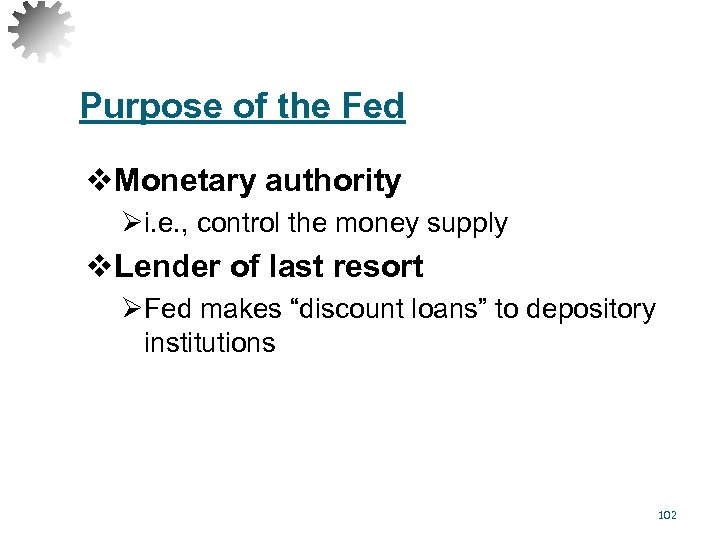
Purpose of the Fed v. Monetary authority Øi. e. , control the money supply v. Lender of last resort ØFed makes “discount loans” to depository institutions 102

Purpose of the Fed v. Monetary authority Øi. e. , control the money supply v. Lender of last resort ØFed makes “discount loans” to depository institutions v. Check clearing 103

Purpose of the Fed v. Monetary authority Øi. e. , control the money supply v. Lender of last resort ØFed makes “discount loans” to depository institutions v. Check clearing v. Bank Supervision 104
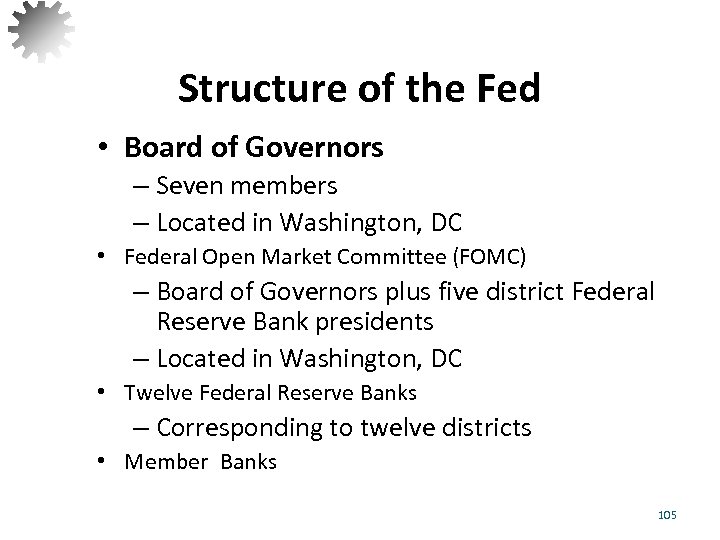
Structure of the Fed • Board of Governors – Seven members – Located in Washington, DC • Federal Open Market Committee (FOMC) – Board of Governors plus five district Federal Reserve Bank presidents – Located in Washington, DC • Twelve Federal Reserve Banks – Corresponding to twelve districts • Member Banks 105

How the Fed Influences Interest Rates • Open Market Operations • Discount Rate Policy • Reserve Requirements 106

Open Market Operations • The Fed buys and sells government securities in the open market. • Buying securities increases the money supply which tends to decrease interest rates. • Selling securities decreases the money supply which tends to increase interest rates. 107

T-bills The Fed $ The public When the Fed buys T-Bills 108
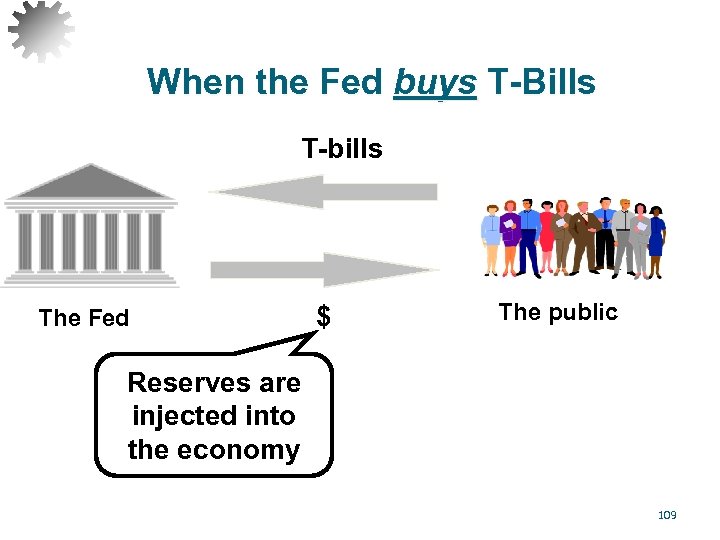
When the Fed buys T-Bills T-bills The Fed $ The public Reserves are injected into the economy 109

When the Fed buys T -bills v. Bank reserves increase. 110

When the Fed buys T-bills v. Bank reserves increase. v. This makes banks more willing to lend, increasing the supply of loanable funds. 111

When the Fed buys T-bills v. Bank reserves increase. v. This makes banks more willing to lend, increasing the supply of loanable funds. v{Supply of LF } {i } 112

When the Fed buys T-bills • Bank reserves increase. • This makes banks more willing to lend, increasing the supply of loanable funds. • {Supply of LF } {i } • Fed decreases rates when it wants to stimulate the economy. 113

T-bills The Fed $ The public When the Fed sells T-Bills 114

When the Fed sells T-Bills T-bills The Fed $ The public Reserves are extracted from the economy 115

When the Fed sells T -bills v. Bank reserves decrease 116

When the Fed sells T-bills v. Bank reserves decrease v. This makes banks less willing to lend, decreasing the supply of loanable funds. 117

When the Fed sells T-bills v. Bank reserves decrease v. This makes banks less willing to lend, decreasing the supply of loanable funds. {Supply of LF } {i } 118

When the Fed sells T-bills • Bank reserves decrease • This makes banks less willing to lend, decreasing the supply of loanable funds. • Fed raises rates when it wants to slow the economy down. {Supply of LF } {i } 119

Discount Rate Policy v. When the Fed increases the discount rate ØThis increases the cost of funds to borrowing depository institutions, causing them to increase the rates they charge. 120

Discount Rate Policy • When the Fed increases the discount rate – This increases the cost of funds to borrowing depository institutions, causing them to increase the rates they charge. • When the Fed decreases the discount rate – This decreases the cost of funds to borrowing depository institutions, causing them to decrease the rates they charge. 121
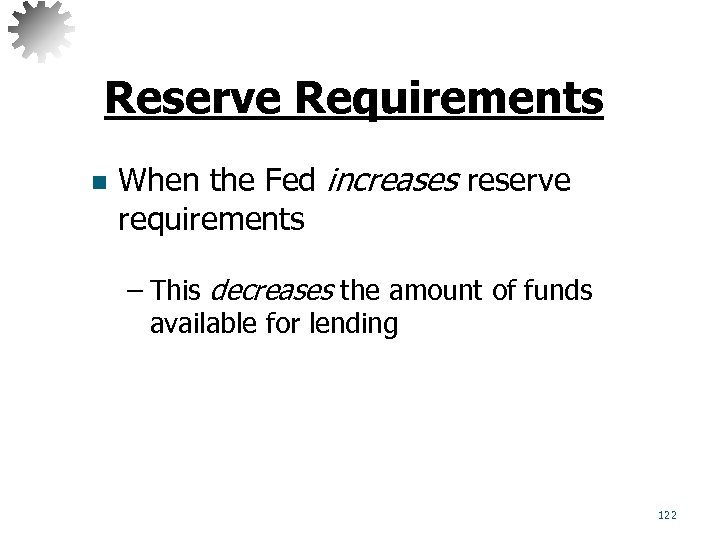
Reserve Requirements n When the Fed increases reserve requirements – This decreases the amount of funds available for lending 122

Reserve Requirements n When the Fed increases reserve requirements – This decreases the amount of funds available for lending – {Supply of LF } {i } 123

Reserve Requirements n When the Fed increases reserve requirements – This decreases the amount of funds available for lending – {Supply of LF } {i } n When the Fed decreases reserve requirements – This increases the amount of funds available for lending 124
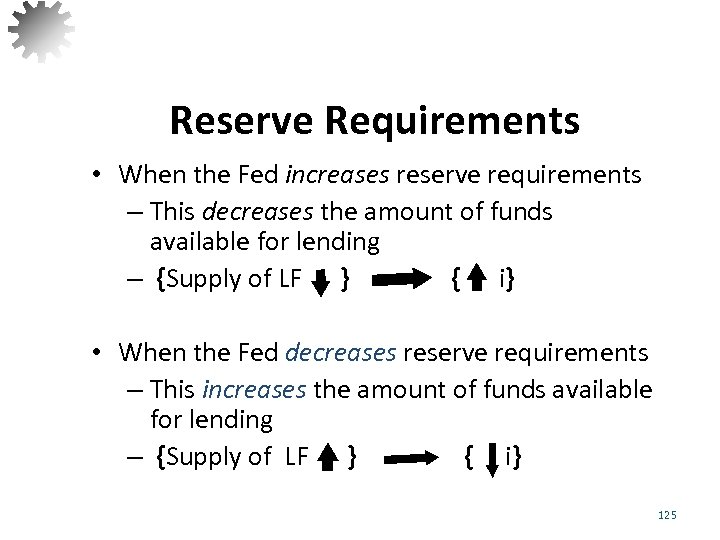
Reserve Requirements • When the Fed increases reserve requirements – This decreases the amount of funds available for lending – {Supply of LF } { i} • When the Fed decreases reserve requirements – This increases the amount of funds available for lending – {Supply of LF } { i} 125

The Federal Reserve • As the central bank of the United States, “The Fed” regulates the financial system, the nation’s money supply, and makes loans to financial institutions. • The Fed consists of twelve district banks, the Federal Open Market Committee, and the Board of Governors. The latter two are located in Washington DC. 126

The Fed Influences Interest Rates by: • Buying and selling federal securities (“open market operations”). – Selling (buying) securities reduces (increases) the money supply which tends to increase (decrease) interest rates. • Discount rate – Increasing the cost of funds to financial institutions tends to increase the rates they charge. • Reserve Requirements – Increasing (decreasing) the amount of non-earning reserves that must be held makes funds less (more) available and generally more (less) costly. 127

Homework Questions 1. Explain how the Fed lowers and raises the federal funds rate. 2. What is the discount window? 3. The Federal Reserve is concerned about a continuing recession; what will they most likely do and how will they accomplish this? 4. What would happen to the standard of living if financial institutions did not exist? Why? 5. Interest rates are about to rise in the near future. Explain how this would impact a negative interest-rate spread of a financial institution. 128
be24c6f497fc34db46eb22af86d36273.ppt